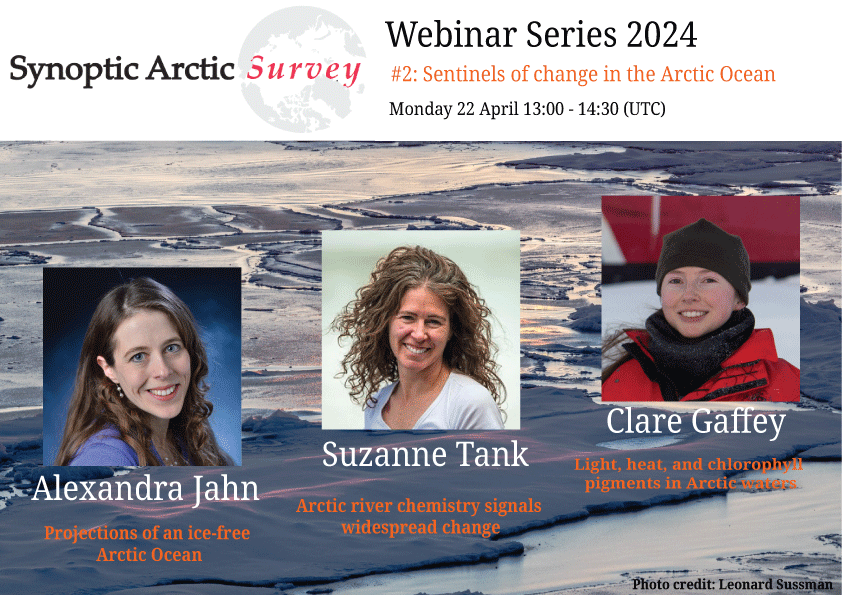Zoom webinar #2 2024: on Monday 22 April, 13:00 – 14:30 UTC

The Synoptic Arctic Survey (SAS) aims to map the present states and ongoing changes of the Arctic Ocean ecosystem, carbon cycle and associated hydrography. It does so by enhancing ongoing ocean monitoring with ship-based measurements.
This webinar showcases some of the striking changes in the Arctic Ocean and their impact on the characteristics and ecosystems of the Arctic Ocean. It will be moderated by Øyvind Paasche, the chair of the SAS scientific steering committee. There will be three solicited talks with room for questions and discussions:
-
- Alexandra Jahn – Associate Professor at the University of Colorado Boulder, USA
- Projections of an ice-free Arctic Ocean
- Suzanne Tank – Associate Professor at the University of Alberta, Canada
- The Arctic Great Rivers Observatory: Long Term Trends in River Chemistry Diagnose Multi-Faceted Northern Change
- Clare Gaffey – PhD candidate at Clark University, USA
- Characteristics of Light, Heat, and Chlorophyll Pigments in the Pacific Arctic During the 2022 U.S. Synoptic Arctic Survey Cruise
- Alexandra Jahn – Associate Professor at the University of Colorado Boulder, USA
The webinar will take place in Zoom. If you would like to join the webinar, please register to receive the meeting link:
https://skjemaker.app.uib.no/view.php?id=16849096
Abstracts of the presentations in this webinar
Projections of an ice-free Arctic Ocean – by Alexandra Jahn
Observed Arctic sea ice losses are a sentinel of anthropogenic climate change. These reductions are projected to continue with ongoing warming, ultimately leading to an ice-free Arctic (sea ice area <1 million km2). In this Review, we synthesize understanding of the timing and regional variability of such an ice-free Arctic. In the September monthly mean, the earliest ice-free conditions (the first single occurrence of an ice-free Arctic) could occur in 2020–2030s under all emission trajectories and are likely to occur by 2050. However, daily September ice-free conditions are expected approximately 4 years earlier on average, with the possibility of preceding monthly metrics by 10 years. Consistently ice-free September conditions (frequent occurrences of an ice-free Arctic) are anticipated by mid-century (by 2035–2067), with emission trajectories determining how often and for how long the Arctic could be ice free. Specifically, there is potential for ice-free conditions in May–January and August–October by 2100 under a high-emission and low-emission scenario, respectively. In all cases, sea ice losses begin in the European Arctic, proceed to the Pacific Arctic and end in the Central Arctic, if becoming ice free at all. Future research must assess the impact of model selection and recalibration on projections, and assess the drivers of internal variability that can cause early ice-free conditions.
More reading: https://www.nature.com/articles/s43017-023-00515-9
The Arctic Great Rivers Observatory: Long Term Trends in River Chemistry Diagnose Multi-Faceted Northern Change – by Suzanne Tank
Large rivers integrate processes occurring throughout their watersheds and are therefore sentinels of change across broad spatial scales. River chemistry also regulates function across Earth’s land-ocean continuum, exerting control on processes ranging from biological production to the carbon cycle. In the rapidly warming Arctic, a wide range of processes might reasonably alter the chemical signature of river water. However, it is unknown how the land-ocean flux of waterborne constituents is changing at the pan-Arctic scale. This talk will present a nearly two decade record of water chemistry that we have collected via the Arctic Great Rivers Observatory, coupled with established discharge records, to show profound shifts in the concentration and transport of biogeochemical constituents at the mouths of large Arctic rivers. Our data encompass the six largest rivers that affect the Arctic Ocean, which together capture two-thirds of the Arctic drainage basin. While some constituents increase substantially at the pan-Arctic scale (alkalinity and associated ions), others decline (nitrate, suspended solids) or remain largely unchanged (dissolved organics). These clear but divergent trends diagnose multi-systems perturbation throughout the pan-Arctic basin and indicate that diverse processes act in concert to affect the flux of biogeochemical constituents from land to ocean. We use our findings to consider how drivers ranging from permafrost thaw to temperature-driven changes in autotrophic and heterotrophic activity may play out across constituent classes, and assess key knowledge gaps. While process models will help diagnose the most critical drivers of change and how these vary among constituents and with geographic scale, our results underscore the need for rapid attention to Earth’s warming climate, its multiplicative effects in the north, and the importance of long-term observations.
More reading: https://www.nature.com/articles/s41561-023-01247-7
Characteristics of Light, Heat, and Chlorophyll Pigments in the Pacific Arctic During the 2022 U.S. Synoptic Arctic Survey Cruise – by Clare Gaffey
Delayed sea ice freeze-up as well as decreased sea ice extent and thickness have profoundly changed light availability in marine waters within the Pacific Arctic Region. The extended duration of the open water and ice-free season leads to increased opportunity for photosynthetic activity and exchanges of heat and energy. Measurement of chlorophyll a concentrations and associated degradation products such a phaeopigments were made in conjunction with optical measurements of light transmittance into the upper ~50 meters of the ocean water column as part of U.S. contribution to the Synoptic Arctic Survey in the central Arctic Ocean, as well as shelf regions of the northeast Chukchi Sea in September–October 2022. Optical profiles into the euphotic zone consisting of 18 channels (320–780 nm) were evaluated in the context of observed fall phytoplankton blooms. The presentation will include discussion of the influence of these blooms on vertical light attenuation and heat distribution, particularly in the northeast Chukchi Sea where fall phytoplankton blooms were observed during the 2022 cruise.

